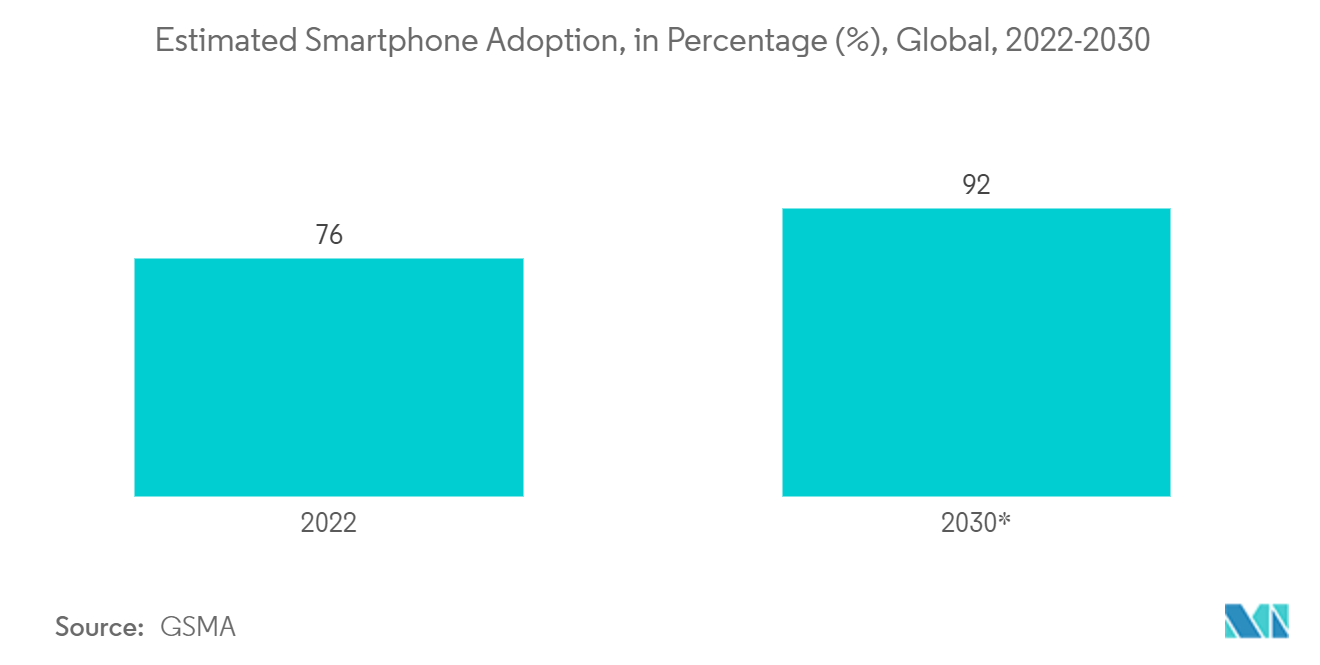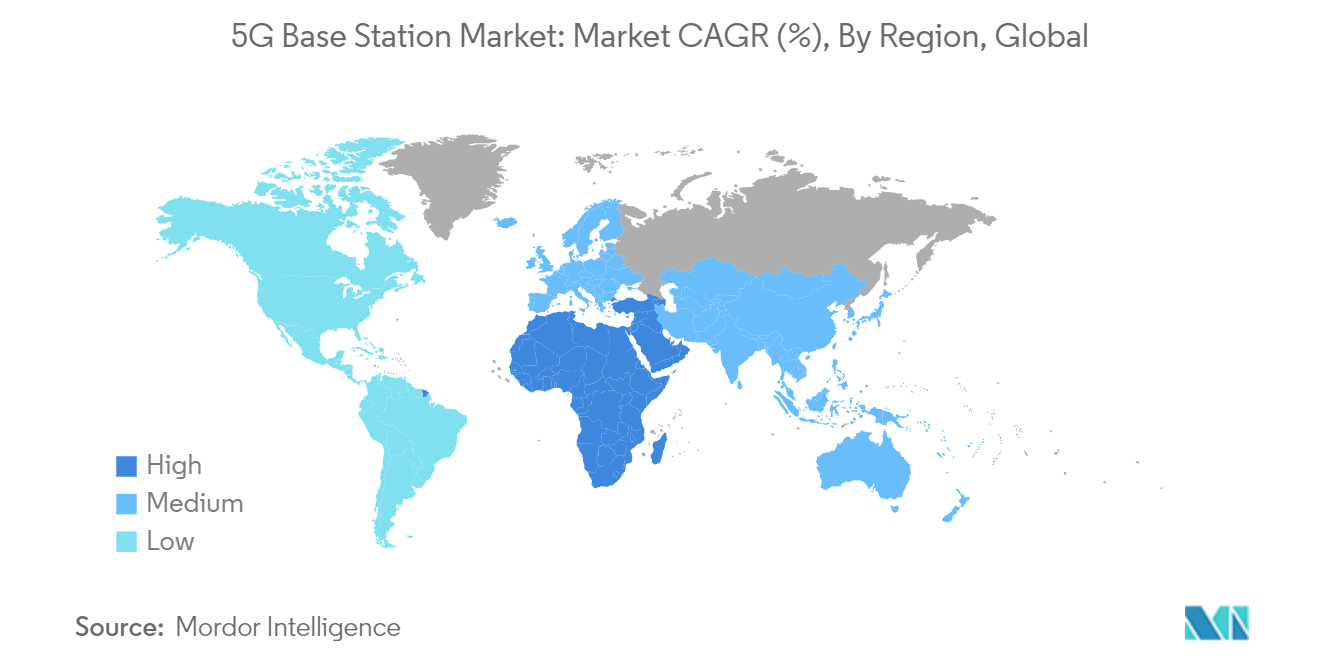Market Trends of 5G Base Station Industry
Smart Cities End User Segment Expected to Witness Significant Growth
- 5G technology serves as a cornerstone for IoT, and given that smart cities fundamentally depend on IoT, the rising applications of 5G in these urban environments are propelling the demand for 5G base stations. Moreover, United Nations data projects that urbanization will hit 68% by 2050. This global trend towards urbanization underscores the need for automated and interconnected cities, positioning 5G as an essential technology for their development. Additionally, the unique combination of high density and low latency that 5G technology offers promises to revolutionize smart cities, further amplifying the demand for 5G base stations in these urban applications worldwide.
- As highlighted in the GSMA Mobile Economy 2024 report, North America is poised to be a frontrunner in the 5G landscape by 2030, with projections indicating a surge in adoption rates, reaching 443 million subscribers (93% of the population). In contrast, Greater China is set to dominate with over 1.64 billion 5G connections, accounting for a staggering 88% of its total connections. Europe, while trailing, is still projected to achieve an impressive 81% penetration, translating to over 654 million 5G connections.
- Furthermore, the global acceleration of smart city initiatives presents a robust demand for 5G base station solutions. For example, in June 2024, ZTE Corporation, one of the leading players in integrated information and communication technology, collaborated with China Telecom's Shanghai Branch to design a blueprint for smart parks leveraging 5G-A technology. This initiative combines technology, nature, and human sentiment, heralding a new chapter in urban development. Deployed in Century Park, the 5G-A ISAC base stations enhance low-altitude security, facilitate drone route planning, and ensure meticulous aerial security oversight.
- By type, small cells are analyzed to hold a significant share in the smart cities segment over the forecast period. The small cells are low-power base stations that are vital to provide coverage and capacity in specific locations, such as streets, buildings, and malls, thus gaining significant traction in smart city applications. Moreover, Small cells on street assets like lampposts and traffic lights can help the level of outdoor densification needed to connect businesses and consumers to superfast 5G networks.
- Furthermore, the role of a small cell 5G base station is becoming paramount to roll out technologies such as 5G in smart cities. Market vendors are recognizing the need to deploy small cells to increase the capacity and coverage of mobile networks in dense cities. Such developments are analyzed to help city councils in smart city planning and subsequently drive the growth of the market.
- For instance, in January 2024, European telecom infrastructure provider Cellnex announced signing an agreement with Urban Service Point (USP) to install small cells in newspaper stands, notably in areas with high population density and high demand for data consumption. This agreement between Cellnex and USP will position newspaper stands as a principal network for the deployment of small cells. This will help city councils to advance toward smart city capabilities and deliver an essential service for citizens.

Middle East and Africa Expected to Witness Significant Growth in the Market
- •The Middle East & Africa are witnessing a surge in 5G technology deployment and adoption, fueling advancements in connectivity, digital transformation, and economic expansion. With a rising appetite for faster, more reliable, and low-latency networks, these regions are channeling significant investments into 5G base stations, opening up new avenues across diverse sectors.
- •The Middle East & Africa is witnessing a swift pace of 5G infrastructure rollout. Qatar, the UAE, Saudi Arabia, and South Africa, have already launched commercial 5G networks. This region stands out with its youthful and tech-savvy population, escalating smartphone penetration, and a surging appetite for high-speed connectivity.
- MEA nations are actively leveraging 5G to drive digital transformations across healthcare, transportation, smart cities, and manufacturing sectors. This includes applications such as telemedicine, IoT-enabled utilities, smart transportation systems, and industrial automation.
- A recent Nokia Mobile Broadband Index study highlights the Middle East's faster 5G adoption compared to Africa. The study also reveals that while many African operators are still refining their 4G business models, the Gulf Cooperation Council (GCC) is leading the 5G charge. Notably, Saudi Arabia is poised to play a pivotal role, contributing significantly to the projected 75% surge in 5G subscribers in the region by 2027, a trend that bodes well for market growth.
- Under its Vision 2030 initiative, Saudi Arabia is aggressively pushing for a digital transformation, leading to widespread adoption and deployment of 5G networks. Telecommunications companies are heavily investing in 5G infrastructure, broadening its reach across the Kingdom and fueling the demand for 5G base stations. For example, in May 2024, Zain KSA, a prominent telecom provider, unveiled plans to invest around USD 426 million to bolster its infrastructure. This initiative aims to extend its services to 66 to 122 cities and governorates across the Kingdom, with Mecca and other Holy sites being prioritized for 5G connectivity.
- Qatar's 5G base station market is experiencing rapid growth driven by the high penetration of 5G, expanding 5G rollouts by major telcos and the presence of major market vendors. Local telecoms in Qatar, including Oredoo Qatar and Vodafone Qatar, have partnered with global vendors like Ericsson, Nokia, and ZTE Corporation, bolstering the growth of the country's 5G base station market.
- For example, in April 2024, Ooredoo Group, pursuing 5G innovation, inked a Memorandum of Understanding (MOU) with global tech giant Nokia, aiming to enhance business connectivity through advanced 5G solutions. The agreement outlines a close collaboration between the two firms to craft and implement 5G private networks, offering tailored solutions that cater to the unique demands of businesses across various sectors.


